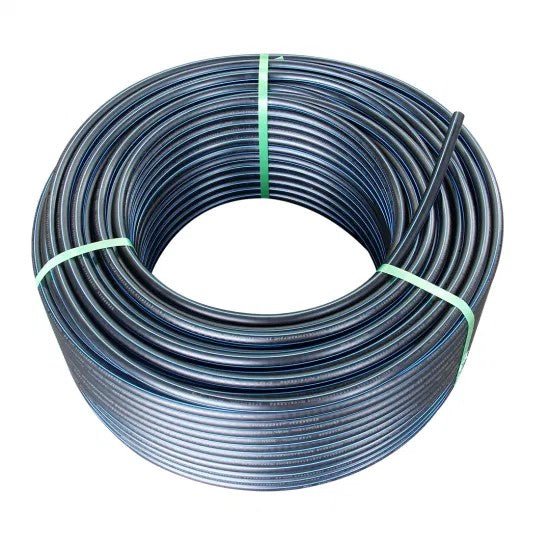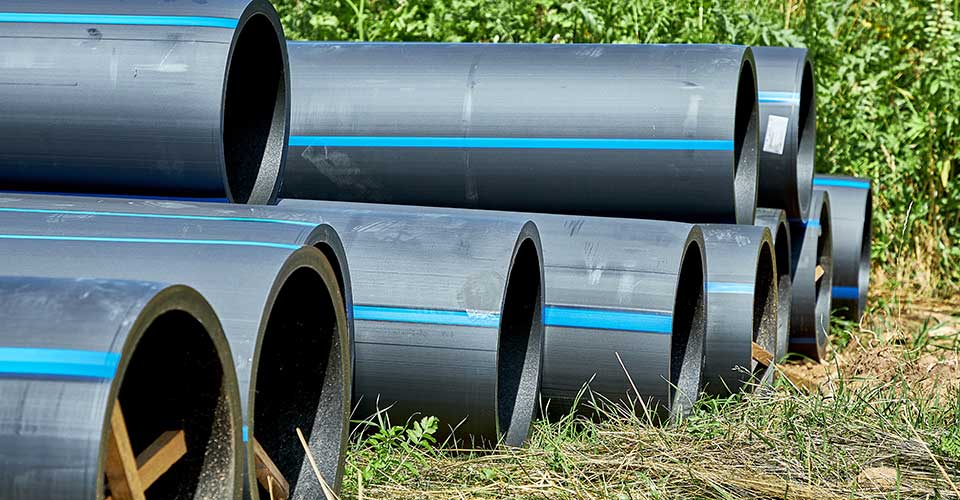Why Partnering with Pipe Supplier American Plastics Midland Ensures Trusted Solutions
Wiki Article
Explore the Production Refine Behind High-Quality HDPE Pipeline and Its Applications
The production process of high-quality HDPE pipes is intricate and methodical. It starts with the option of basic materials that boost efficiency. Following this, ethylene goes through polymerization to develop resin, which is then shaped via extrusion. Quality assurance is paramount, guaranteeing that the final item fulfills rigid criteria. The journey of HDPE pipelines does not end with manufacturing. Their applications throughout various industries disclose a wider importance worth analyzing.Understanding HDPE: Residences and Advantages

High-density polyethylene (HDPE) is a functional thermoplastic recognized for its toughness and resistance to different ecological aspects. This material shows outstanding tensile strength, making it suitable for demanding applications. Its low-density structure adds to a light-weight product, promoting ease of dealing with and installation. HDPE additionally showcases impressive resistance to chemicals, which lessens degradation when exposed to severe compounds.
The product's low dampness absorption even more improves its longevity, making it suitable for use in pipes and tank. In addition, HDPE is resistant to ultraviolet (UV) radiation, ensuring that products keep their integrity also when subjected to sunlight. Its adaptability permits for the creation of detailed shapes without compromising stamina. The environment-friendly nature of HDPE, typically originated from recycled materials, contributes to its charm, promoting lasting methods in production. In general, these homes and benefits make HDPE a recommended choice for different commercial and customer applications.
Raw Product Option for HDPE Production
The selection of resources for HDPE production is necessary to verify the end product satisfies the preferred specs and high quality requirements. High-density polyethylene (HDPE) is mostly created from polymerized ethylene, originated from nonrenewable fuel sources such as gas or unrefined oil. The top quality of these feedstocks significantly affects the mechanical and thermal residential properties of the final HDPE.Ingredients additionally play a substantial function in improving HDPE's performance, including anti-oxidants, UV stabilizers, and colorants, which improve durability and resistance to ecological variables. The option procedure have to take into consideration not just the chemical make-up of the raw products yet additionally their handling features to assure efficient production.
Furthermore, the sourcing of basic materials need to focus on sustainability and compliance with environmental policies, as responsible practices are important in today's market. Eventually, cautious raw material option lays the foundation for generating high-grade HDPE pipes suitable for varied applications.
The Extrusion Refine: Shaping HDPE Pipeline
The extrusion process plays an important role in forming HDPE pipelines, starting with careful material preparation techniques that assure perfect flow and consistency. Equally crucial is the style of the die, which straight affects the last dimensions and surface top quality of the pipeline. With each other, these factors contribute greatly to the performance and high quality of HDPE pipeline manufacturing.Material Prep Work Strategies
Effective manufacturing of HDPE pipelines starts with precise product prep work techniques, especially the extrusion procedure. Throughout this phase, high-density polyethylene resin is first dried to remove moisture, guaranteeing excellent flow features. The material is after that fed into the extruder, where it undergoes heating and melting, changing right into a thick state. This heating process is thoroughly managed to keep the material's integrity and efficiency. The liquified HDPE is compelled through a die, shaping it into a constant pipeline kind. Correct temperature management during extrusion is necessary, as it directly affects the material's residential or commercial properties and the end product top quality. When formed, the HDPE pipeline is cooled down and reduced to specified sizes, ready for succeeding processing and applications.Die Layout Value
Accuracy in die layout plays an important function in the extrusion process of HDPE pipes. The die serves as the final shaping device, straight influencing the pipe's measurements, wall thickness, and surface finish. A well-designed die warranties consistent product circulation, decreasing problems such as irregularities and weak spots. The geometry of the die have to be maximized to suit the particular residential properties of HDPE, including its thickness and thermal habits throughout extrusion. Additionally, the cooling rate of the product as it goes through the die can substantially influence the pipe's structural honesty. As a result, investing in innovative die innovation is important for manufacturers intending to create premium HDPE pipes that fulfill market requirements and client expectations.Quality Assurance Steps in HDPE Production
Although different aspects affect the high quality of HDPE pipeline manufacturing, efficient quality control procedures are critical to ensure uniformity and reliability in the last product. Key top quality control practices consist of extensive product inspection, validating that the raw polyethylene meets well-known requirements for pureness and density. During the extrusion procedure, parameters such as temperature, pressure, and cooling time are carefully monitored to maintain dimensional accuracy and structural stabilityIn enhancement, post-production testing is vital; makers usually conduct hydrostatic examinations to assess the pipe's strength and resistance to stress. Aesthetic examinations for surface area defects further enhance quality control. Certification from relevant standards companies, like ASTM or ISO, gives an added layer of credibility. By executing these extensive quality assurance procedures, makers can decrease issues, boost efficiency, and make sure that the HDPE pipelines meet the particular requirements of different applications, eventually bring about consumer complete satisfaction and depend on in the item.
Applications of HDPE Pipeline Across Industries
HDPE pipes are used throughout numerous fields due to their sturdiness and convenience. In water distribution systems, they guarantee efficient delivery, while in wastewater administration, they provide reliable services for waste transportation. Furthermore, agricultural irrigation networks take advantage of HDPE's resistance to rust and adaptability, making it a perfect choice for modern-day farming practices.
Water Circulation Equipments
A significant variety of sectors rely upon high-density polyethylene (HDPE) pipes for efficient water circulation systems. Recognized for their durability and resistance to corrosion, HDPE pipes are widely made use of in metropolitan water supply networks, farming watering, and commercial applications. Their lightweight nature helps with easy handling and installation, reducing labor costs and time. In addition, HDPE pipelines can fit different pressure levels, making them ideal for both reduced and high-pressure systems. Midland TX HDPE Pipe Fittings in Stock. The adaptability of the product enables for seamless integration right into existing framework, lessening the requirement for comprehensive excavation. HDPE's resistance to chemical seeping guarantees that the water provided stays secure and clean, making it an optimal selection for maintaining the quality of drinkable water throughout various industries.Wastewater Administration Solutions
Reliable water circulation systems also lead the way for ingenious wastewater management options, where high-density polyethylene (HDPE) pipelines play a substantial duty. Renowned for their resilience and resistance to rust, HDPE pipes are suitable for moving wastewater in numerous setups. Their adaptability enables very easy installment in complicated atmospheres, lessening the requirement for substantial excavation. In addition, HDPE's smooth indoor surface area minimizes friction, improving flow prices and effectiveness. These pipes are also resistant to chemical leaching, ensuring that impurities do not endanger the surrounding atmosphere. Industries, towns, and treatment centers significantly count on HDPE pipes for their reliability and durability, making them a recommended option for contemporary wastewater management systems. This flexibility highlights the vital importance of HDPE pipes across countless applications.Agricultural Watering Networks
Agricultural irrigation networks profit considerably from using high-density polyethylene (HDPE) pipelines, which supply efficient and reliable water shipment to crops. HDPE pipelines are lightweight, making them very easy to deliver and install, while their adaptability enables for various arrangements in diverse surfaces. These pipes show outstanding resistance to deterioration, chemicals, and UV radiation, making sure resilience in rough agricultural settings. Furthermore, their smooth indoor surface decreases friction loss, maximizing water flow and lowering power prices related to pumping. The longevity of HDPE pipes, often surpassing 50 years, adds to lower upkeep and replacement expenditures. Consequently, farmers progressively count on HDPE pipes to improve irrigation effectiveness and advertise sustainable agricultural methods, inevitably resulting in boosted plant yields and resource preservation.Future Fads in HDPE Pipe Technology
As the need for sustainable and efficient framework grows, developments in HDPE pipeline modern technology are poised to change different sectors. Emerging trends consist of the integration of clever innovations, such as sensing units and IoT capacities, which assist in real-time monitoring of pipe problems, minimizing upkeep costs and protecting against leaks. In addition, the development of innovative manufacturing methods, such as 3D printing, is making it possible for the production of facility, customized pipeline designs that satisfy specific task needs.The emphasis on recycling and circular economic situation methods is driving the development of HDPE pipelines made from recycled products, enhancing sustainability. Enhanced jointing approaches, such as electro-fusion and mechanical fittings, are likewise improving installation effectiveness and reliability. The expanding focus on ecological regulations is pushing producers to adopt greener production processes, guaranteeing that HDPE pipelines not only meet market requirements but likewise cultivate an even more lasting future for framework advancement.
Regularly Asked Questions
Just How Does HDPE Contrast to Various Other Plastic Materials?
HDPE outperforms many other plastic materials concerning durability, chemical resistance, and versatility. Its reduced density and high tensile stamina make it optimal for different applications, often exceeding options in both performance and longevity.What Are the Ecological Effects of HDPE Manufacturing?
The environmental impacts of HDPE manufacturing consist of greenhouse gas emissions, power usage, Pipe Manufacturing Midland TX and prospective pollution from producing procedures. In addition, incorrect disposal can cause soil and water contamination, elevating concerns regarding long-term environmental impacts.Can HDPE Water Lines Be Recycled?
Yes, HDPE pipelines can be recycled. Numerous facilities accept utilized HDPE for handling, changing it right into new products. This recycling contributes to sustainability efforts, decreasing plastic waste while conserving sources and power in the production cycle.What Is the Life Expectancy of HDPE Piping?

How Do Temperature Variants Influence HDPE Pipe Performance?
Temperature variants substantially influence HDPE pipeline efficiency, influencing adaptability and strength. Heats can cause softening, while low temperatures may create brittleness, inevitably influencing the pipeline's durability and viability for different applications in varied settings.Report this wiki page